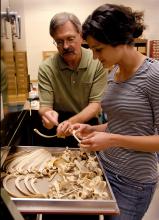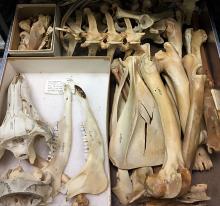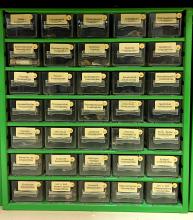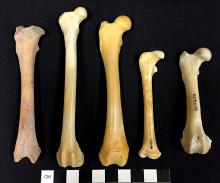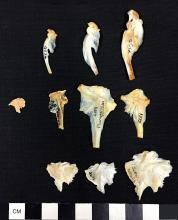Dr. Terry Martin and McMillan Intern Angela Perri try to match a rib fragment from an archaeological site to a deer rib in the ISM comparative collection. Image taken by Doug Carr.
Kinds of Animals
Most zooarchaeologists first divide a sample of animal remains from an excavation level at an archaeological site into broad categories. For example, we sort the bones into those from mammals, birds, reptiles, amphibians, and fish. We sort shells into bivalves (freshwater mussels in our area) and gastropods (aquatic and terrestrial snails). Sometimes we can only identify the remains to these broad taxonomic categories. Sometimes we can identify remains more precisely. We identify remains to more precise levels by comparing them to modern comparative specimens of known species. The zooarchaeologists in the image are comparing a rib from an archaeological site to a rib from a modern deer skeleton.
Trays in comparative collection cabinets contain whole skeletons for animals commonly found at Midwestern archaeological sites. This tray has bones from white-tailed deer. Image taken by Bonnie Styles.
The Illinois State Museum has a large comparative collection of animal skeletons from mammals, birds, reptiles, amphibians, and fish. Rows of cabinets house whole skeletons from individual animals such as the deer skeleton in the tray in the image.
Dr. Robert Warren rehoused the ISM's freshwater mussel comparative collection with a grant from the Institute of Museum and Library Services. Image taken by Doug Carr.
The Illinois State Museum has a large comparative collection of shells from freshwater mussels, freshwater and terrestrial gastropods (snails), and marine shells.
Each tray in this synoptic collection cabinet holds the same bone element for each of the species in the freshwater catfish family. It allows researchers to quickly identify bones recognized as catfish to body part and species. Image taken by Bonnie Styles.
To speed up identification, the Museum also has synoptic collections. These collections group single elements from a related groups of animals. For example, the green cabinet in the image has trays of the same element from all the species of catfish (family Ictaluridae) that we might encounter for a Midwestern archaeological site. We have similar synoptic collections for other families of fish. We also have synoptic collections for classes of animals of similar body size, such as small mammals and small birds, as well as synoptic collections for turtles, amphibians, and freshwater mussels. These collections help researchers make a preliminary identification. However, it is often necessary to also look at the whole skeleton collections.
It is difficult to compare fragmentary bones and shells from archaeological sites to images of bones and shells. Comparing to a skeleton lets you closely examine all sides of the bone and peer into the natural cavities and openings. You can’t do that with a photograph in a book!
In the following images, see if you can match the bone from Modoc Rock Shelter on the left in each image to the bone from the same species from our modern comparative collection. It would be easier to do if you had the comparative specimens. In each case, look at the size and shape of the bone and any special characters such as the number and shape of the teeth. Remember that the archaeological specimen may not be whole, and it may be from an animal that is different in age or sex from the animal represented in the comparative specimen. We compare bones from archaeological sites to animals in the same class and size range. We also often compare our archaeological specimens to more than one individual for a species to be certain that we have correctly identified them. We have not included all the possibilities in the examples below, but have included the species we identified for the archaeological specimen.
Match the mandible from Modoc Rock Shelter on the far left in the image to the comparative specimen it most closely resembles. Image taken by Doug Carr.
The bone on left in the image is a right mandible (jaw bone) from a medium-size mammal. We excavated the bone from Archaic deposits at Modoc Rock Shelter in 1984. The tops of some of the teeth of the archaeological specimen have been broken off. All of the bones to the right of the archaeological specimen are left mandibles from comparative specimens. The second bone from the left is from a gray fox (Urocyon cinereoargenteus). The third bone from the left is from a river otter (Lontra canadensis). The fourth bone from the left is from a raccoon (Procyon lotor). The bone on the far right is from a woodchuck (Marmota monax). What is the species for the archaeological specimen?
Match the femur shaft from Modoc Rock Shelter to the femur from the comparative collection that it most closely resembles. Image taken by Bonnie Styles.
The archaeological specimen from Modoc Rock Shelter is on the far left in the image. It is a right femur (upper back leg) shaft from a medium-size mammal. The proximal and distal epiphyses were not fused and are missing from our mystery bone. The same element is shown for the comparative specimens, but the epiphyses for most are fused to the shaft. The second bone from the left is from a gray fox. The third bone from the left is from a raccoon, the fourth bone from the left is from a Virginia opossum (Didelphis virginiana), and its distal epiphysis is missing. The bone on the far right is from a river otter. What is the species for the archaeological specimen?
Match the turtle hypoplastron fragment from Modoc Rock Shelter to the hypoplastron from the comparative collection that it most closely resembles. Image taken by Bonnie Styles.
The archaeological specimen on the far left in the image is a left hypoplastron (a paired bone in the plastron, the lower shell of a turtle). Only a fragment of the bone is present. The same body part is shown for four comparative specimens. The top bone in the center of the image is from a common snapping turtle (Chelydra serpentina), the lower bone in the center of the image is from an eastern painted turtle (Chrysemys picta). The bone on the top right is from an eastern box turtle (Terrapene carolina). The bone on the bottom right is from a false map turtle (Graptemys psuedogeographica). What species does the archaeological specimen best match?
Match the catfish hyomandibular bone (far left side of image) from Modoc Rock Shelter to the correct row of hyomandibular bones from the comparative collection to determine which fish family is represented. Image taken by Bonnie Styles.
Fish remains can be challenging to identify. For this example, we will only ask you to identify the fish family for the archaeological specimen. There are many more families of fish and many more species in each family than we are showing.
The bone on the far left is a left hyomandibular bone (a paired bone on the side of the skull) from a fish recovered at Modoc Rock Shelter. The same body part is presented for three different families of fish. The bones in the top row are all from the sucker family (Catostomidae). From left to right they are from a black redhorse (Moxostoma duquesnei), shorthead redhorse (Moxostoma macrolepidotum), and a bigmouth buffalo (Ictiobus cyprinellus). The bones in the center row of comparative specimens are from the sunfish family (Centrarchidae). From left to right the bones are from a white crappie (Pomoxis annularis), largemouth bass (Micropterus salmoides), and smallmouth bass (Micropterus dolomieu). The bones in the bottom row of comparative specimens are from the catfish family (Ictaluridae). From left to right they are from brown bullhead (Ameiurus nebulosus), black bullhead (Ameiurus melas), and yellow bullhead (Ameiurus natalis). Which family has bones that resemble the Modoc bone?
| Common Name | Scientific Name |
|---|---|
| White-tailed deer | Ameiurus melas |
| Eastern cottontail | Terrapene carolina |
| Eastern gray squirrel | Amblema placata |
| Wild Turkey | Odocoileus virginianus |
| Mallard | Meleagris gallopavo |
| Eastern box turtle | Sylvilagus floridanus |
| Black bullhead | Anas platyrhynchos |
| Threeridge | Sciurus carolinensis |
We attempt to identify the taxon of archaeological specimens to the finest degree possible, ideally to genus and species. Common names may vary from region to region, and scientific names are occasionally updated, especially with ongoing genetic research. For our grant project we use the scientific names for species provided in the Integrated Taxonomic Information System (www.itis.com) so that we all use the same name to refer to the same kind of animal.
Look at the lists of common names and scientific names of animal species that are often recovered at Archaic Period archaeological sites. The scientific names are not properly aligned with the common names. Use the Integrated Taxonomic Information System to match the common and scientific names for these animals. You can enter either the common or scientific name in ITIS (www.itis.com) to complete this task.



